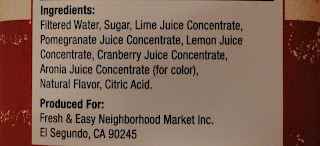For the last few days I've written about water and how we prefer to consume our water and other drinks (meaning a beverage which is NOT water and not primarily a food). We like them a bit cooler or a bit warmer than our body temperature, depending on the drink.
It turns out that a little elementary mathematics comes in handy in dealing with drinks, as we must consider heat, cold, volume, percentages of dilution, etc. Here are a few reasons why some math is necessary when shopping (or indeed when trying to sell juice). Imagine if these were applied to the proverbial Lemonade Stand!
[Code of Federal Regulations]
[Title 21, Volume 2][Revised as of April 1, 2002]
From the U.S. Government Printing Office via GPO Access [CITE: 21CFR102.33]
TITLE 21--FOOD AND DRUGS
CHAPTER I--FOOD AND DRUG ADMINISTRATION, DEPARTMENT OF HEALTH AND HUMAN SERVICES
PART 102--COMMON OR USUAL NAME FOR NONSTANDARDIZED FOODS
Subpart B--Requirements for Specific Nonstandardized Foods
Sec. 102.33 Beverages that contain fruit or vegetable juice.
(edited slightly for ease of reading)
(a)
For a carbonated or non-carbonated beverage that contains more than 0% and less than 100% fruit or vegetable juice, and, if the usual name uses the term juice, it shall include a qualifying term such as beverage, cocktail, or drink to advise the consumer that the product is less than 100% juice (diluted grape juice beverage or grape juice drink).
(b)
If the product is a diluted multiple-juice beverage or blend of single-strength juices, then the names of those juices must be shown in descending order of volume unless the name specifically shows that the juice with the represented flavor is used only as a flavoring (raspberry-flavored apple and pear juice drink). The presence of added natural flavors is not required to be declared in the name of the beverage.
(c)
If a diluted multiple-juice beverage or blend of juices contains a juice that is named or implied on the label (represented juice), and also contains a juice other than the named or implied juice (non-represented juice), then the product name shall indicate that the represented juice is not the only juice present (Apple blend; apple juice in a blend of two other fruit juices).
(d)
In a diluted multiple-juice beverage or blend of single-strength juices where one or more, but not all, of the juices are named on the label, and where the named juice is not the predominant juice, the product name shall indicate that the named juice is present as a flavor or flavoring (Raspcranberry; raspberry and cranberry flavored juice drink); or it shall include the amount of the named juice, declared in a 5% range (Raspcranberry; raspberry and cranberry juice beverage, 10-15% cranberry juice and 3-8% raspberry juice).
(e)
The common or usual name of a juice that has been chemically modified shall include a description of the exact nature of the modification (acid-reduced cranberry juice, or deflavored, decolored grape juice).
(f)
If the product is a beverage that contains a juice whose color, taste, or other properties have been modified to the extent that the original juice is no longer recognizable, or if its nutrient profile has been diminished to a level below the normal nutrient range for the juice, then the fruits or vegetables from which the modified juice was derived may not be depicted in pictures on the label.
(g)
(1) If one or more juices in a juice beverage is made from concentrate, the name of the juice must include a term such as from concentrate or reconstituted, in a type font no less than one-half the height of the letters in the name of the juice.
(2) If the juice is 100% single-species juice consisting of juice directly pressed from a fruit or vegetable whose Brix level is adjusted (raised) by the addition of juice concentrate from the same fruit or vegetable, it need not include a statement that it is from concentrate. However, if water is added to this 100% juice to adjust (lower) the Brix level, the product shall be labeled from concentrate or reconstituted.
Now that you know all this, have fun inspecting the labels of these juice-like drink beverages we found in the local market. The first is what I would call a brightly-colored, flavored soft drink:
After tasting this, I don't know what I would call it, but it doesn't taste like either Pomegranate or Blueberry juice. It's sweetened with sugar and with concentrated pear and apple juices.
This is some tart red stuff that looks like juice, tastes like juice, but can't be called juice.
This is the most complicated label and very tasty stuff it is too, but what would you call it? Do we benefit from these complex creations? It's not a hot summer day but a cool winter day - yet it still tastes very nice, in my opinion.
Ah, orange juice. Not from concentrate. Turns out it was the cheapest of all these choices, too!










